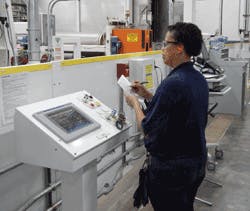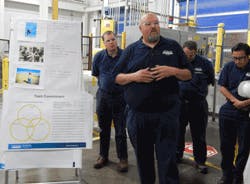To build a thriving safety culture, companies need to focus on both the procedures and processes that guide their operations, as well as the attitudes and behaviors of every employee.
It's not as simple as creating new workplace rules. It involves a new way of thinking about fatality and injury prevention.
Because many EHS professionals now are expected to manage a multitude of responsibilities – often without the necessary bandwidth or support staff – safety needs to become everyone's responsibility. Safe behaviors should be modeled at every level of employment – from the C Suite to the shop floor – across all functions, from manufacturing to sales to the back office.
By promoting accountability in every aspect of a business, companies can foster mutual respect, commitment, collaboration and open dialogue among employees of all levels. These are the hallmarks of a safety culture.
It's not enough to simply describe safety as a priority – because priorities often change. Companies need to make safety a core value, knowing that a safe and healthy workforce translates to a healthy bottom line.
No One-Size-Fits-All Approach
The foundation of a robust safety culture is a cohesive environmental, health and safety management system.
An effective EHS-management system outlines the necessary regulatory requirements and standards for safe workplace operations, while allowing room for customization. At Kimberly-Clark Professional (KCP), we recognize that each of our mills has a distinctive workplace culture, which is why our approach to safety is not one-size-fits-all.
For example, our mill in Corinth, Miss., which manufactures WypAll-brand utility wipers, employs 135 people along with another 30 to 50 contracted employees who provide services for our mill. Every employee is bound by our mill's safety policy and "Fatal 10" safety rules, which are unique to our mill but consistent with similar tools used at other KCP facilities.
The "Fatal 10" defines the actions that all employees should not take, as violating them could result in an injury or a loss of life. While adhering to the requirements and standards of our company's overall EHS-management system, these actions are reflective of the distinct risk areas identified as most critical for our mill.
The mill in Corinth has achieved excellent safety outcomes, including eight Crystal Eagle awards. The award recognizes mills that have achieved a full year without a reportable injury.
However, this success did not come easily. It was the result of a continuing focus on refining and improving our approach to safety.
The mill opened in 1985, serving primarily as a distribution center, and added manufacturing operations in 2001. In that same year, the mill launched "Project Cornerstone." The project was created as a result of the newly installed manufacturing machinery that required bigger and better performance equipment to keep up with production capacity. Along with increased productivity, however, came the increased risk of hand and arm injuries.
In light of the high potential for safety hazards, mill leadership delegated safety responsibilities among the workforce, which helped to drive employee accountability.
The next step was to assess our equipment and make sure we had the safest equipment possible, including machinery guarding and electrical-circuitry protections.
Assessing Gaps in Safety
In 2005, mill leadership took a hard look at our approach to health and safety management. While they acknowledged that the work force was engaging in many positive practices, they also noted the lack of an overarching, sustainable EHS system.
To resolve this, our mill conducted a comprehensive audit of safety policies and procedures. As a result, it became one of the KCP mills to pioneer an EHS-management-system audit that assesses our gaps in safety.
Since that time, our mill increasingly has been focused on safety performance and continuous improvement.
Once this process was put in place, it became extremely important to convey employee expectations and promote safety ownership. This began by encouraging safe practices on the mill floor.
While there always has been a focus on zero injuries, mill leadership worked to gain a better understanding of which behaviors were leading to positive-activity-based performance and which behaviors needed to be improved. This behavior-assessment process continues to be our focus today.
By assessing the behaviors that have the potential to result in injuries – instead of simply concentrating on the idea of zero injuries – our mill has been able to mitigate risks associated with safety behaviors and improve safety outcomes year after year.
Elements of a Safety Culture
The mill at Corinth serves as an example of how to improve workplace-safety outcomes by using a cohesive EHS-management system to create a culture of safety.
A true safety culture has a number of fundamental components. Here are a few of them:
• Make safety a core value. Companies must ensure that all levels of the organization are committed to making health and safety a core value to achieve zero fatalities and injuries. Thus, leaders must be inspired and committed, and employees must be engaged and empowered. This vision should be integrated into every aspect of work procedures and be evident throughout a business, from the newest employees to the most experienced members.
• Identify safety champions. At each site, companies should give all employees the opportunity to become involved in safety management. Safety leaders are vital to engaging all employees in making safety their primary goal, in improving safety every day and in fostering safety cultures at the local level. Likewise, safety teams should be responsible for educating employees on safety policies and procedures and helping to create a work force culture in which safety is a shared responsibility.
• Provide health and safety training to everyone. Health and safety should be presented in a way that employees easily can access information and readily engage in helping to guide workplace improvement. To make sure that safety stays top of mind, our mill in Corinth developed the "STOPP" (Stop, Think, Observe, Plan and Perform) method. This method encourages employees to stop and think about their behaviors before they perform a task. Employees should ask themselves, "What are the hazards that I am going to encounter on this task?" The mill developed a hazard-assessment tool to ensure that the method is applied consistently. The tool provides employees a checklist of potential hazards and a place to categorize the severity of each hazard.
• View risk management as a performance-improvement tool. Risk management should be treated as a way to improve business performance, not merely as a necessary cost of doing business. Investing in safety and health pays dividends in the form of improved productivity, higher morale, lower absenteeism and reduced workers' compensation costs, among other benefits.
• Organize and measure performance-quality indicators. Organize performance-quality indictors around two general groups of measures: lagging indicators that focus on reactive measures, and leading indicators that are drawn from proactive measures. Consisting of a variety of both lagging and leading indicators, this holistic measurement system ensures that managers and employees are unified in their efforts to achieve zero fatalities and injuries.
Visual-Management Tools
Visual-management tools such as safety dashboards can help communicate progress being made and potential gaps as defined by leading and lagging performance indicators.
The dashboards should be positioned in high-traffic areas so they can be easily referenced. For optimal effectiveness, dashboards should be utilized at all levels and discussed regularly during shift changes and team meetings.
The dashboards also can be used to determine topics for safety meetings and to prioritize continuous-improvement activities around safety issues.
Dashboards are helpful tools for researching, measuring and analyzing the current state of safety and health within a company and for gaining a better understanding of the factors that prevent a work force from performing at its best.
A clear understanding of these barriers enables a company to make informed decisions about what risk-mitigation strategies should be implemented once a safety barrier has been identified, allowing decisions to be proactive versus reactive.
Defining Clear Obligations
Ultimately, trust plays an essential role in achieving a culture of safety. Everyone in a team environment must feel encouraged and comfortable when reporting an incident and correcting unsafe practices, regardless of company hierarchy.
This can be encouraged through the creation of safety obligations. At KCP, we call them "The Three Obligations," and all employees display them on their badges regardless of their job titles or responsibilities.
While these obligations are not identical in all mills and facilities, the basic principles are the same:
- I am obligated to refuse to complete any task that I feel is unsafe.
- I am obligated to confront anyone performing an unsafe act.
- If I am confronted by another regarding the safety of my own task, I am obligated to stop my work and discuss it.
Building on these obligations, KCP mill leaders and employees cultivate trust by discussing mill-safety goals during safety call-to-action sessions.
In these sessions, which are conducted in every mill, all teams come together to reflect on the previous year's safety results. After working together to solve any workplace-safety problems, facilities move forward from the sessions with a team plan and individual commitments.
To create a robust safety culture, companies not only should be removing hazards and developing safety procedures but also aggressively working to change risk-prone attitudes and behaviors. Companies achieve this outcome by improving each employee's situational awareness and by offering opportunities for employees to be involved.
When workers embrace safety standards and practice safe behaviors, they take ownership of their actions, which creates a culture of safety. And by establishing a culture of safety, businesses will become more productive, efficient and profitable.
Grover Hardin is the plant manager for Kimberly-Clark Professional's Corinth, Miss., facility.


